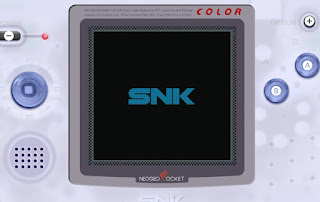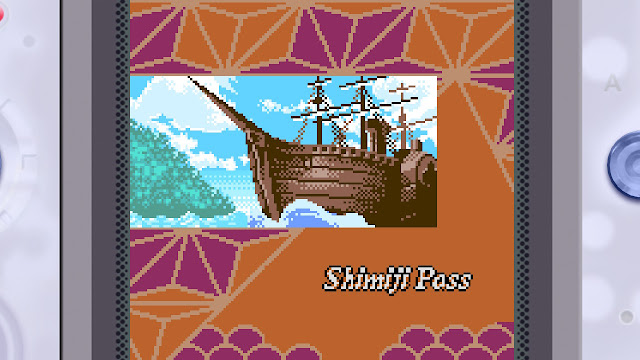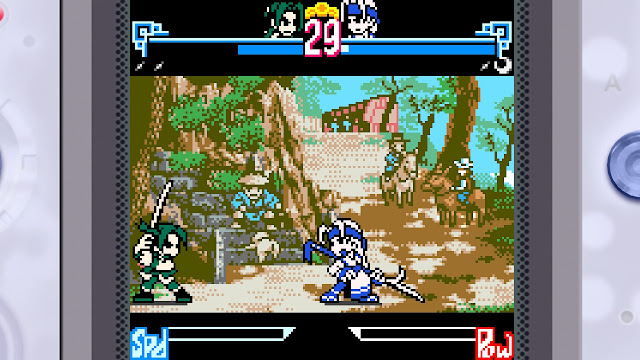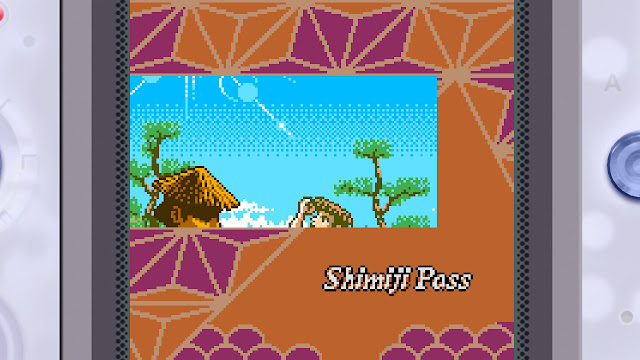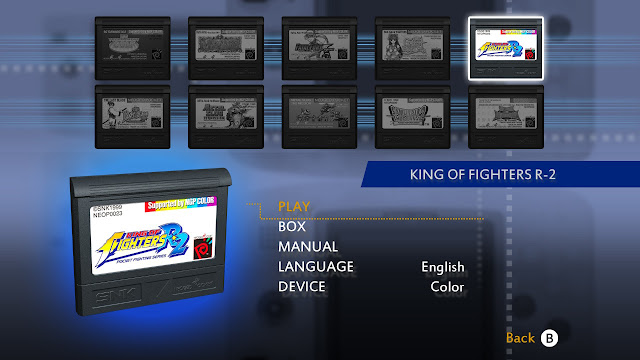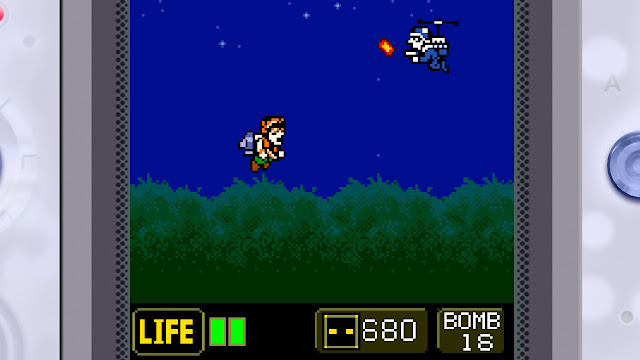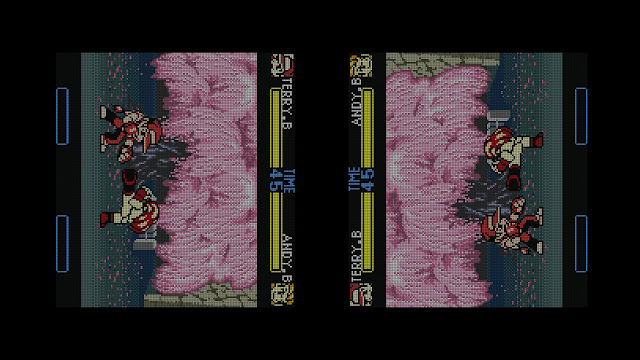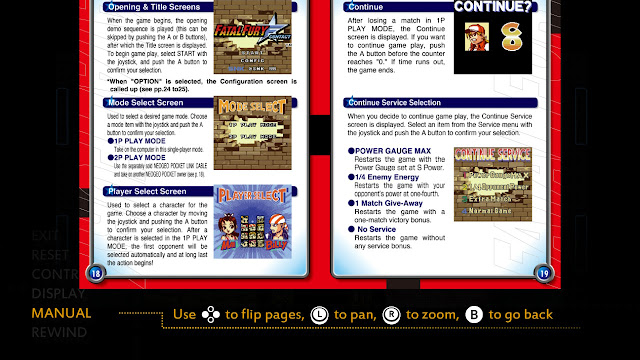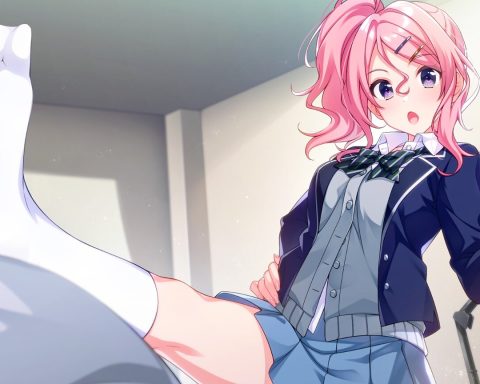Sometimes the most unexpected gifts are the most welcome. I hadn’t heard anything about a Neo Geo Pocket Color compilation coming to Switch, but I’m happy to get it all the same. I love that the Switch is rapidly becoming a hub for retro compilations, with companies like Capcom, Namco, SEGA and especially SNK getting in on the party. A good chunk of SNK’s Neo Geo library is already on the eShop as standalone titles, but we haven’t seen a lot of love for the Neo Geo Pocket Color (NGPC) yet.
The NGPC is an overlooked handheld – released worldwide between the Game Boy Color and the Game Boy Advance, it was, for two sweet years the market leader in handheld technology. It was a proper 16-bit console with a clicky eight-direction joystick and two face buttons which were perfectly tailored to SNK’s catalogue of fighters and fast-paced action games. Despite strong support from SNK’s in-house developers and a rapidly amassing library of excellent games, the NGPC was discontinued after less than a year of sale in western markets, owing to SNK’s bankruptcy in Japan as well as poor market share compared to Nintendo’s products.
It’s a shame because the NGPC’s games all hold up really well, even twenty years after its release. The emulation done by Code Mystics has done a great job of porting ten titles to the Switch (individual mini-reviews below) and the package features excellent quality-of-life improvements for modern players. The ten games all come with digital reproductions of the game boxes, cartridges and manuals, for nostalgia’s sake. There are also customisable skins for your virtual console, and you can choose to play pixel-for-pixel or zoom in to fill the Switch’s screen. You can also apply separate filters to the graphics, either drawing attention to the individual pixels, or filling in the blanks so that you get a clean picture. SNK’s in-house teams were always masters of pixel art, and their work really shows in the bright colours and crisp animations in all the games on show. There’s also a handy rewind feature accessible from the menu, or by sliding a finger across the bottom of the Switch’s touch-screen. There are no save-states unfortunately, but your progress on each game is saved automatically if you exit it.
This release is a one-off purchase rather than a hub-software like Capcom Arcade Stadium, which means that anyone who bought a separate edition of any of the 10 games included is effectively getting the short end of the stick. There are four games – Big Tournament Golf, Metal Slug 1st and 2nd Mission, and Dark Arms: Beast Buster – which weren’t available as standalones which still gives the package some value, but it’s a shame that this collection doesn’t compile together past purchases. I imagine when Volume 2 of the NGPC collection comes out, it’ll be a mix of lesser iterations of these fighting games – like King of Fighters R-1 and Samurai Shodown 1, as well as the other sports games that round out the NGPC’s small library. One could hope for lesser-known RPG’s like Biomotor Unitron or even a Japan import, too. As it is though, all the ten games included in Volume 1 are impressive in their own way. Here’s the lowdown:
The Fighting Games
There’s an established hierarchy to fighting games on how they are best played, and it goes:
Custom Gamepad > Original Arcade Cabinet > Console Controller > Computer Keyboard >>> Handheld Device
And I’m no stranger to this – I’ve played Street Fighter GBC and Tekken Advance, and I can attest they both reach the coveted standard of “they did their best, but also, why though”. I don’t know how many people in the 90’s played the gorgeously animated games by Capcom, Namco and SNK in the arcades, and then cried out for a version they could play on the bus. But popular demand aside, the Neo Geo Pocket Colour supplied it in droves – and each one in this collection is worth playing.
There are six separate fighting games available in Volume 1 of the collection, each a unique representation of its property rather than a scaled-down port of an arcade game. Amazingly, every one has redone sprites and controls to make sure it works well for the handheld system. This was aided by the original NGPC’s eight-direction joystick, which enabled precise controls compared to the D-Pad on Nintendo’s handhelds. The use of taps and hard-presses for weak and strong moves respectively, means that SNK’s trademark four-button fighting style translates perfectly onto the NGPC’s face buttons, though this can be hard to differentiate on the tiny buttons of the Switch Joy-Con. None of the manuals have instructions for each character’s special moves though, and this isn’t available via the menu either – so you’ll need to look up a guide for each game. All these small issues aside, with each title you do feel like you’re playing a fighting game in an arcade. I can’t claim expertise on any of these games, but here’s a rapid breakdown of all of them:
SNK Gals’ Fighters: A unique game and not an arcade port, SNK Gal Fighters is one of the more standard fighting games of the lot. It features the female fighters from across SNK’s properties (11 total, three unlockable), and their movesets feel true to their arcade counterparts. The personality of the characters comes across from the animations and the before/after fight dialogues. There are unlockable items from beating each character’s story mode, mostly cosmetics – but I like the added replay value available. A training mode and 5 difficulty levels makes this one of the deeper options available in this collection, though the difficulty does skew on the easy side.
Samurai Shodown 2: I don’t personally like the Samurai Shodown games because they feel more defensively-oriented to me: because the characters wield swords and every hit should feel significant, fights are over in four or five good hits and gameplay revolves around edging forwards and backwards to bait your opponent into making a mistake. This manifests in some extreme hit/stun flow in the NGPC version, and I can’t tell if this is a performance issue or an intentional part of the gameplay. This is also a game where the difference between weak and strong hits matters, and with the difficulty that the Switch hardware brings, this wasn’t one of my favourites in the collection.
For what it’s worth, each of these fighting games has its own distinctive flavour, so with the choice of six you’ll find one that you want to devote your time to. The simplified controls, training modes, easier difficulty and added single-player content means that these are a more accessible entry into each respective franchise compared to the full-size Neo Geo counterparts. The David Sirlin led Pocket Rumble, also available on modern devices, seems to take a lot of inspiration from these ports on the Pocket Colour, down to the two-attack-buttons, reduced health bar and adorably pixelated characters – showing the longevity of this design style. These games are certainly not lesser versions of the flagship fighters, as other handheld ports like Street Fighter GBC or Tekken Advance are. All of the games in the collection are fun and playable, and because it’s SNK, you’ll be spoilt for choice.
And then there are the other titles in the collection:
Neo Turf Masters: Big Tournament Golf: It’s golf. The upshot is that this is one of the best handheld golf games from the 90’s – Mario Golf GBC might have had a better story and progression system, but the graphics and robust playability of Neo Turf Masters is unmatched. Be aware that the putting is a bit wonky, but at least it’s wonky in a consistent way. Six characters and three courses of 18 holes makes for a wonderfully moreish golf game.
Metal Slug 1st & 2nd Mission: People love the Metal Slug series on the Neo Geo for good reason, but they often forget the mixed quality that the original series had. Metal Slug 2 released with slowdown so bad that required the update of Metal Slug X to fix it. Metal Slug 3 is playable in digital incarnations, but in arcades it was a notoriously difficult slog that would eat 10-20 credits if the player wanted any hope of seeing the ending.
The two Metal Slug titles on NGPC Vol. 1, 1st and 2nd mission, follow this mixed-bag ethos too. Technical issues plague both – though the second experiences much worse slowdown than the first, especially when using heavy weapons that create lots of sprites. There’s a reduced amount of enemies on screen at once, and the animations are understandably pared back compared to the mainline titles, though both games still look good. The lack of face buttons on the original NGPC means that switching between guns and bombs is done with the Start button, and there’s no way to pause once a level’s begun. The Switch collection thankfully fixes this through its overlay menu and rewind system.
Both entries are classic Metal Slug – fast-paced run-and-gun action with gorgeous animation and big, screen-sized boss battles. I like the way the handheld’s limitations, and the fact that these games were never meant for arcade, means the developers thought more deeply about level sizes: the levels in both NGPC games are bite-sized with varied challenges, offering something new with each minute. HP-bars and plenty of health pickups means that the level of difficulty is manageable, now that the developers are designing experiences to be completed, instead of merely receptacles for spare change. It’s a great entry-level Metal Slug experience, if you can handle the performance issues.
Dark Arms: Beast Buster: The most unusual game in the collection, Dark Arms is a spin-off of the arcade top-down-shooter Beast Buster, which sees the player developing living weapons in a Dark Fantasy inspired action-RPG. The NGPC did have a couple of RPG titles, and this one does a good job of showing off what the handheld was capable of. It has a rudimentary monster capturing system which lets the player feed and evolve guns to fill out their arsenal, and there’s a good range of weapons from beam guns, melee weapons and the classic shotgun and machine gun.
The designs are very forward-thinking for 1999 – before the indie market started tacking exp-bars to everything, here was SNK creating an engaging weapon upgrade system and a sizeable menagerie of monsters that required a diverse loadout. The enemy designs are memorable, fitting the Hammer-Horror theme: spooky but not overtly horrifying. Each also has varied attack patterns so you can choose how you approach it. There are six levels total, which isn’t a lot, but a day-night cycle keeps things interesting by varying enemy spawns. I think of this game as being a good comparison to the Gargoyle’s Quest/Demon Crest series by Capcom: horror-themed action games with mild RPG elements, which let players choose either grinding or dexterity to power through levels.
– Harvard L.
Contributor

